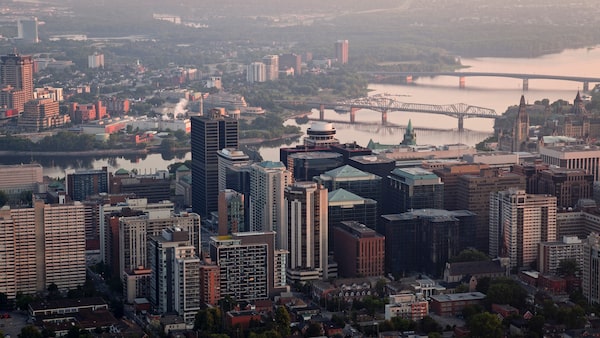
Approximately half of Ottawa’s inventory of office space is occupied by federal employees.Getty Images
The return-to-office policy of the federal government – Ottawa’s largest employer – has resulted in a unique set of challenges in its downtown office market, commercial real estate insiders say.
Last year, the Treasury Board of Canada Secretariat announced a common hybrid model in which its employees would be required to return to the office for two or three days a week.
A resulting two-week national strike in April – with more than 155,000 public servants on the sidelines – disrupted some government services, with the work-from-home policy being the linchpin for the work stoppage.
A survey released in June by the Professional Institute of the Public Service of Canada showed that 70 per cent of the respondents were “dissatisfied with how the return-to-office policies were implemented,” which has left some commercial real estate veterans in Ottawa wondering what’s next for the downtown core that’s seeing record-high vacancy rates.
Alan Doak, a partner of Proveras Commercial Realty, says when and how often public service employees come to the office is a manager-to-manager situation, an uncertainty that has left many tenants and landlords in the lurch.
Downtown investment
Crown corporations, large national associations and pseudo-governmental entities tend to follow the public service and it remains to be seen how many of those organizations will downsize, move or right-size their real estate footprint, Mr. Doak says.
“We’ve got [a] bottleneck and we don’t have any clarity on it,” Mr. Doak says. “As real estate professionals, it’s time to ask the government to signal that if we care about what the capital of our country looks like, we need to start investing in downtown. And the best way to do that is for people to return to the office [for] the majority of their working hours.”
To encourage business support for the area, Shawn Hamilton, a principal at Proveras, organized a recent event called Ottawa is Open for Business. It was attended by 300-plus people including representatives from all three levels of government.
“Calgary has a higher vacancy rate than we do, but their occupancy rate is higher than Ottawa because when the private businesses call people back, people go.
— Alan Doak, partner at Proveras Commercial Realty
“We wanted to say to the private sector, ‘Come on in, the water is fine,’” Mr. Hamilton says.
The gap in communications from the federal government is “causing a downward spiral in our business,” he adds.
Paul Thompson, deputy minister of Public Services and Procurement (PSPC), recently told the standing committee on government operations that instead of a 40-per-cent reduction in its real estate holdings, a 50-per-cent reduction is now more likely. The PSPC holds 6.9 million square metres of office space in Canada, more than half in Ottawa-Gatineau.
“We can deal with a compressing federal government, but we just need to understand how it’s going to be done so we can adjust,” Mr. Hamilton says.
Hot topic
According to a CBRE study, Ottawa’s downtown vacancy rate in the second quarter was just over 15 per cent. That’s below the national average of 18.1 per cent, but it’s the highest in Ottawa since CBRE began tracking the stat in 1996.
Calgary had the country’s highest vacancy rate, at 31.5 per cent, but it was one of three cities with a positive net absorption in this year’s second quarter.
“Other major markets have their challenges as well, but we have a totally different type of worker here,” Mr. Doak says. “Calgary has a higher vacancy rate than we do, but their occupancy rate is higher than Ottawa because when the private businesses call people back, people go.”
Ottawa’s working population is about 737,000 and the federal government employs more than 113,000 people – up from 100,000 in 2021.
But what has happened to the offices those workers occupy?
Louis Karam, senior vice-president and managing director of CBRE in Ottawa, says it’s “the hottest topic” in the city.
Fifty per cent of the city’s inventory of office space is occupied by the public service. While the PSPC’s next steps and the balance of remote versus work-from-home are important, they’re not the only drivers of what’s happening in Ottawa.
Remote work
“We are staring at a looming recession, interest-rate hikes … the tech sector that had been really strong in Ottawa is on the sidelines for now as they’ve been recalibrating after the huge growth in the pandemic,” Mr. Karam says. “All those things combined have put us in this situation.”
Mr. Karam, who says CBRE has “walked the walk” and moved to a right-sized office on the 19th floor of a building in Ottawa’s downtown core from a large office in the Little Italy neighbourhood, believes the numbers won’t look good for the next 12 to 24 months.
“But after that, things are set to improve,” he explains. “The PSPC’s portfolio reduction of 50 per cent is not going to happen overnight. By the time it does, all these other factors will have moved on.”
Mr. Karam says both employers and the City of Ottawa need to work in conjunction to make back-to-office efforts into downtown easier, including tackling Ottawa’s much-troubled transit system.
“It’s clear remote work is not going away,” Mr. Karam says, “but it’s a question of how many days in the office that doesn’t take away from office space and amenities.”